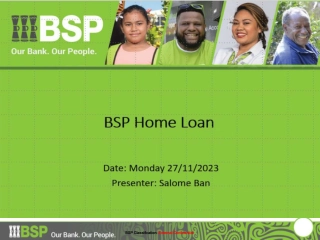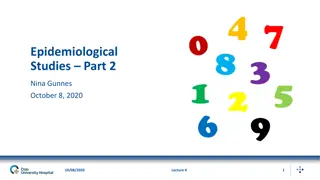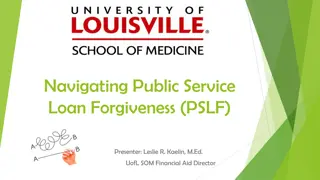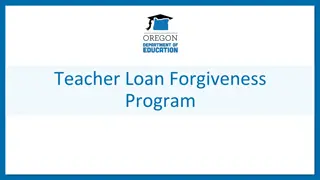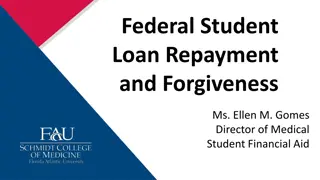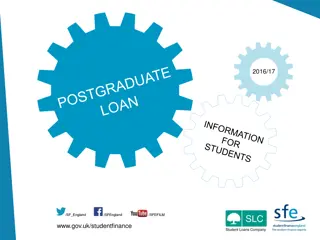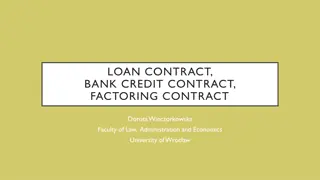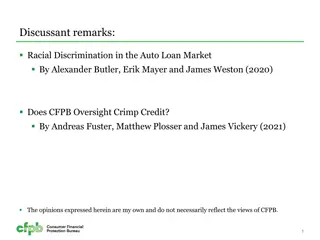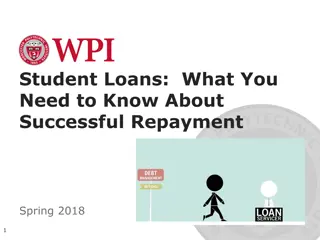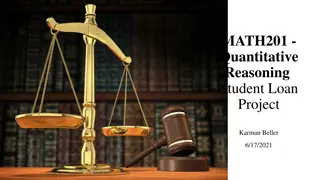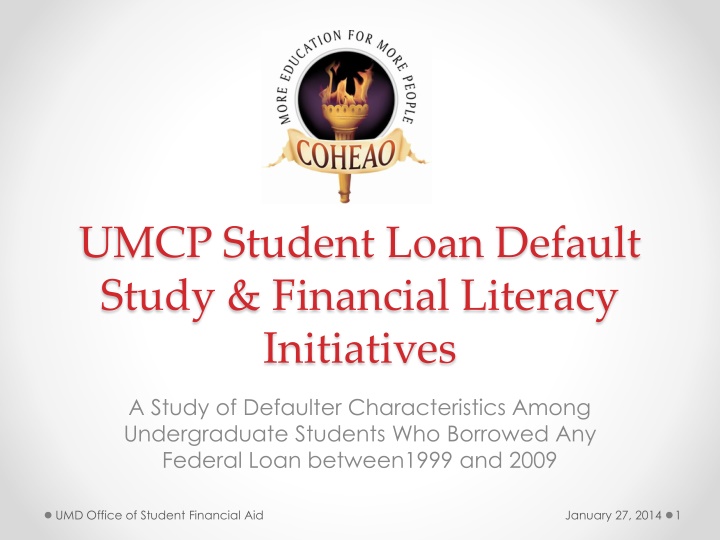
UMCP Student Loan Default Study & Financial Literacy Initiatives
Explore a study on the characteristics of undergraduate students who defaulted on federal loans between 1999 and 2009 at UMCP. Discover factors leading to defaults, including academic performance, demographics, and financial traits. Analyze default rates and trends.
Download Presentation

Please find below an Image/Link to download the presentation.
The content on the website is provided AS IS for your information and personal use only. It may not be sold, licensed, or shared on other websites without obtaining consent from the author. If you encounter any issues during the download, it is possible that the publisher has removed the file from their server.
You are allowed to download the files provided on this website for personal or commercial use, subject to the condition that they are used lawfully. All files are the property of their respective owners.
The content on the website is provided AS IS for your information and personal use only. It may not be sold, licensed, or shared on other websites without obtaining consent from the author.
E N D
Presentation Transcript
UMCP Student Loan Default Study & Financial Literacy Initiatives A Study of Defaulter Characteristics Among Undergraduate Students Who Borrowed Any Federal Loan between1999 and 2009 UMD Office of Student Financial Aid January 27, 2014 1
Purpose and Scope The purpose of this study is to determine the indices that cause students to default on their student loans. Describe the academic performance, demographics, and financial characteristics of students who defaulted. Identify which characteristics are associated with the highest default rates. Examine the relationship between graduation and each characteristic. UMD Office of Student Financial Aid January 27, 2014 2
Method All degree-seeking undergraduate students who took any federal loan during a year they were enrolled between 1999 and 2009 (N=43,825). Population was matched to a report of all students from the University of Maryland who defaulted on their loan(s) from Jan 1999 to June 2013 (N=2,031, 5%) Not the same as default rate (no time limits, not cohort analysis) All defaulters (3,084) also analyzed separately. UMD Office of Student Financial Aid January 27, 2014 3
Historical Default Rate UMCP s cohort default rate is consistently lower than the national average. The UMCP default rate ranges from 1.2% in FY 2005 to 3.9% in FY 2008. The average rate is 2.2%. UMD Office of Student Financial Aid January 27, 2014 4
Defaulter Characteristics Median age at loan (origination date of 1st defaulted loan) 21 Median age at first default 30 45% F 55% M Gender UMD Office of Student Financial Aid January 27, 2014 5
Defaulter Characteristics, Cont. All full time enrollment 38% Continuous enrollment 74% First term as NewTransfer 46% Out of state student 31% Percent who graduated 41% UMD Office of Student Financial Aid January 27, 2014 6
Default Rate by Total Number of Loans UMD Office of Student Financial Aid January 27, 2014 7
Time to Default Among students who default, about half do so within five years UMD Office of Student Financial Aid January 27, 2014 8
Default Rate by Graduation Students that do not graduate have default rates more than 3.7 times higher than those that do graduate. UMD Office of Student Financial Aid January 27, 2014 9
Default Rate by Gender Males have a slightly higher risk of default overall. Failure to graduate increases risk of default among males but not females. UMD Office of Student Financial Aid January 27, 2014 10
Default Rate by Race/Ethnicity While over half (58%) of the loan takers are White, just 33% of the defaulters are White. Black/African American students make up 22% of the cohort but 52% of defaulters. Among students who do not graduate, Black/African American students are almost three times as likely as White students to default. UMD Office of Student Financial Aid January 27, 2014 11
Default Rate by Dependency 15% of the loan takers filed FAFSAs as independents. They have default rates 2.3 times higher than dependent students. UMD Office of Student Financial Aid January 27, 2014 12
Default Rate by Transfer Status Transfer students are more likely to default than first time students (6% vs 4%). They are more likely to default regardless of whether they graduate. UMD Office of Student Financial Aid January 27, 2014 13
Default Rate by Residency Status In state and out of state students have very similar default rates, but if they do not graduate, out of state students are more likely to default than instate students. UMD Office of Student Financial Aid January 27, 2014 14
Default Rate by School of Major Students in Undergraduate Studies have the highest default rate overall, however loan takers in Special Programs have the highest default rate among graduates. While students in the Business, Architecture and Journalism schools are at the least risk of defaulting, students in these schools who do not graduate have default rates similar to (if not higher than) those not graduating from other schools. UMD Office of Student Financial Aid January 27, 2014 15
Default Rate by Terms Enrolled Students enrolled in 13+ terms were more likely to default regardless of their graduation outcome, but those that did not graduate were almost three times more likely to default than those that did graduate. UMD Office of Student Financial Aid January 27, 2014 16
Default Rate by High School GPA Students with low high school GPAs were much more likely to default regardless of whether they completed their undergraduate degree. Almost one in five students with low high school GPA s who did not graduate from college defaulted on their loans. UMD Office of Student Financial Aid January 27, 2014 17
Default Rate by UG GPA * Those with higher cumulative undergraduate GPAs are least likely to default: C students are 6.5 times more likely to default than A students (8.5% vs 1.3%) Failure to graduate doubles the C student s risk of default (13% vs 6%). *UG GPA is the cumulative GPA as of the last term enrolled as an undergraduate. UMD Office of Student Financial Aid January 27, 2014 18
Default Rate by Average EFC On average, the yearly EFC of students who defaulted was $3,843 less than those who did not default ($9,421.52 compared to $5,578.16) (not shown below) UMD Office of Student Financial Aid January 27, 2014 19
Default Rate by Total Loan Amount In general, students taking very high cumulative loan amounts are more likely to default. Among students who graduate, the risk of default does not increase until the total loan amount exceeds $20,000. Students taking more than $20,000 in loans who do not graduate are 3.6 times more likely to default than those who do graduate. UMD Office of Student Financial Aid January 27, 2014 20
Major Indices for Risk of Defaulting Failure to graduate Socio-Economic Barriers Independent filing status Enrollment for 13+ Terms C and below student Undeclared major student Cumulative loans > $20,000; total # loans >10 UMD Office of Student Financial Aid January 27, 2014 21
Default Rates and Graduation Graduation seems to mediate other risk factors for defaulting. Academic performance measures are the most powerful indicator of potential to default if graduation is not considered. Failure to graduate has the biggest effect on default rates among African American students, students who were enrolled for more than 13 terms, and students who have total loan amounts greater than $20,000, and. UMD Office of Student Financial Aid January 27, 2014 22
So What? Now What? Adjusted our Financial Aid Website Personalized Counseling Loan borrowers with Distinct Characteristics Created a Bookmark and Pens Teach Javanomics at Univ100 Class Enhanced Satisfactory Academic Policy Requirements Profiled Student Loan Borrowing Using 8% Rule for Indebtedness Expanded our Senior Debt Cap program In Progress Working with Experts in the Industry for Campus Wide Literacy Hired a Senior Financial Aid Financial Literacy Expert UMD Office of Student Financial Aid January 27, 2014 23
UMD Office of Student Financial Aid January 27, 2014 24
Questions? Sarah Bauder Assistant Vice President Financial Aid and Enrollment Services sbauder@umd.edu 301-314-8279 UMD Office of Student Financial Aid January 27, 2014 25

